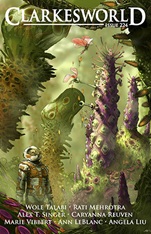“Brainstem Disco, 2191” by Angela Liu
“We, the Fleet” by Alex T. Singer
“Oh Time Thy Pyramids” by Ann LeBlanc
“Yarn Theory” by Marie Vibbert
“The Library of the Apocalypse” by Rati Mehrotra
“Descent” by Wole Talabi
“Proxima One” by Caryanna Reuven
Reviewed by Victoria Silverwolf
“Brainstem Disco, 2191” by Angela Liu takes place within a virtual reality dance club. The narrator shares this imaginary environment with a lover. Flashbacks recall their experiences together, joyful or tragic.
The reader may be able to predict why the narrator is within the VR discotheque. Although the plot is not surprising, the story has emotional power, in particular the way it makes use of music.
The narrator of “We, the Fleet” by Alex T. Singer is a sentient, semi-organic starship, sent to an uninhabited world in order to create multiple other machines that will bring life to the dead planet. A spaceship carrying a single human passenger crashes on the planet. The narrator directs the other machines to save her life, changing her into a cybernetic organism resembling themselves. Horrified at first by this transformation, the woman eventually aids the machines when they face a crisis. The two very different kinds of beings learn what they have in common.
The story varies in mood from cold and clinical, appropriate to the narrator, to warm and emotional. This shift in tone is aided by the fact that the narrator thinks of itself as the mother of multiple daughters. The transition between these two styles is smooth, but a couple of scenes in which the only human character behaves like a comic book superhero are jarring.
“Oh Time Thy Pyramids” by Ann LeBlanc is a difficult story to describe, or even understand. Unless I am very much mistaken, it has something to do with an infinitely large structure that allows a so-called Queen to conquer time and space by acting as an oscillating universe. The narrator is an insect-like being within this structure. After remaining motionless for an immense length of time, it begins to move, eventually encountering a human (or human-like being) with whom an emotional relationship is formed.
This synopsis is probably badly misleading, because the story is full of apparent contradictions and concepts that are hard to comprehend. Premises like voiceless songs and an incarnation of Death that is also a spear-like weapon create an exotic mood, but are extremely confusing. One can admire the author’s imagination, but wish for some clarity.
“Yarn Theory” by Marie Vibbert is a fairly brief tale in which a mathematician discovers that a coded message from an alien species can be understood through the patterns in her knitting. It’s a pleasant little story, but it probably requires a decent understanding of the mathematics of knitting to fully appreciate it.
“The Library of the Apocalypse” by Rati Mehrotra takes place in a future Toronto devastated by war. The narrator is a robot (or possibly a cyborg) linked mentally to a group of young people surviving as best as they can in the ruins. Once in a while a sign appears out of nowhere, directing them to a library where they can enter the worlds described in books. Those who visit these other realities do not always return.
The setting, mood, and premise remind me of Robert Sheckley’s 1959 story “The Store of the Worlds” (also known as “The World of Heart’s Desire”) although the two works are different in many ways. This bittersweet combination of science fiction and fantasy manages to mix the two genres in an effective way. It can be read as an allegory for escapism and the power of imagination. The conclusion offers a touch of hope without denying the grim reality in which the story takes place.
The novella “Descent” by Wole Talabi takes place on a planet where human colonists live on mountains that jut high above an atmosphere that grows thicker and deadlier the deeper one goes. The protagonist has a plan to go much farther into the depths than anyone else. Funded by a business executive who wants to exploit energy from the storms deep in the atmosphere, he descends with two other humans and an alien native to the planet. The expedition does not go as planned.
The setting is similar to the planet Plateau, found in the Known Space series of Larry Niven. Appropriately, much of the story has the feeling of hard science fiction, with detailed worldbuilding. This is the work’s main appeal, along with vivid descriptions of the deepest part of the atmosphere. Other concepts are less convincing, such as the fact that the storms are somehow sonic in nature, or that some individuals have a psychic connection with the storms. The climax turns into pure mysticism, which seems out of place. The opening makes it clear that a disaster strikes the expedition, lessening the suspense.
“Proxima One” by Caryanna Reuven is translated from Spanish by Sue Burke. Several sentient probes, all known by the name mentioned in the title, are sent into the galaxy in search of life. The story consists of the various experiences of these probes, and how they vary their missions depending on what they find.
This tale of exploration is notable for the sweeping scale of its vision, from the nearest star to other universes. The latter premise creates a sense of wonder, but at the expense of plausibility. (The way in which a probe is able to detect other universes is left unexplained.)
Victoria Silverwolf knows nothing about knitting.
 Clarkesworld #224, May 2025
Clarkesworld #224, May 2025